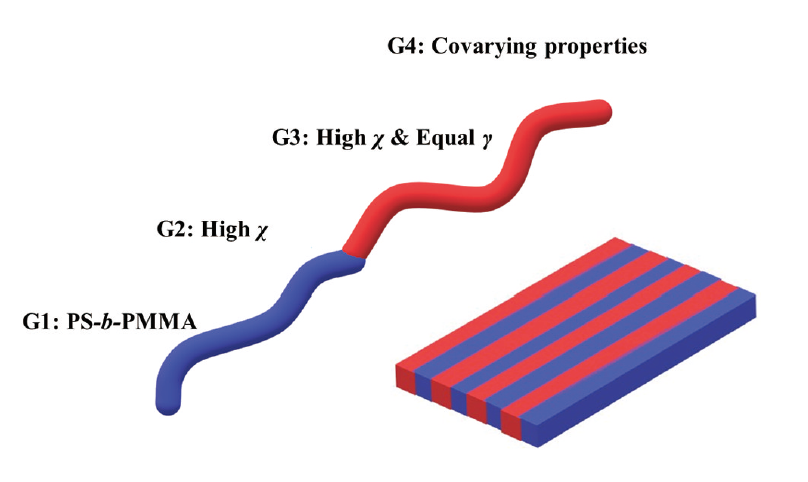 PDF(17535 KB)
PDF(17535 KB)


Advanced Design of Block Copolymers for Nanolithography
Chen Leilei, Tao Yongxin, Hu Xin, Feng Hongbo, Zhu Ning, Guo Kai
Prog Chem ›› 2023, Vol. 35 ›› Issue (11) : 1613-1624.
 PDF(17535 KB)
PDF(17535 KB)
 PDF(17535 KB)
PDF(17535 KB)
Advanced Design of Block Copolymers for Nanolithography
Directed self-assembly (DSA) of block copolymer (BCP) has been identified as the potential strategy for the next-generation semiconductor manufacturing. The typical representative of the first generation (G1) of block copolymer for nanolithography is polystyrene-block-polymethylmethacrylate (PS-b-PMMA). DSA of PS-b-PMMA enables limited half pitch (0.5L0) of 11 nm due to the low Flory-Huggins interaction parameter (χ). The second generation (G2) of BCP is developed with the feature of high χ. Solvent anneal or top-coat is employed for the G2 BCP to form the perpendicular lamellae orientation. Towards industry friendly thermal anneal, high χ BCP with equal surface energy (γ) is reported as the third generation (G3) BCP. Recently, based on Materials Genome Initiative (MGI) concept, optimized design of block copolymers with covarying properties (G4) for nanolithography is presented to meet specific application criteria. G4 BCP achieves not only high χ and equal γ, but also high throughput synthesis, 4~10 nm half pitch patterns, and controlled segregation strength. This review focuses on the advanced design of G3 and G4 BCP for nanolithography. Moreover, the challenges and opportunities are discussed for the further development of DSA of BCP.
1 Introduction
2 Highχblock copolymers with equalγ(G3)
2.1 A-b-B block copolymer
2.2 A-b-(B-r-C)block copolymer
2.3(A-r-B)-b-C block copolymer
2.4 A-b-B-b-C block copolymer
3 Block copolymers with covarying properties(G4)
4 Conclusion and outlook

block copolymer / directed self-assembly / nanolithography / Flory-Huggins interaction parameter / surface energy
| [1] |
|
| [2] |
|
| [3] |
|
| [4] |
|
| [5] |
|
| [6] |
|
| [7] |
|
| [8] |
|
| [9] |
|
| [10] |
|
| [11] |
|
| [12] |
|
| [13] |
|
| [14] |
|
| [15] |
|
| [16] |
|
| [17] |
|
| [18] |
|
| [19] |
|
| [20] |
( 李小欧, 顾雪松, 刘亚栋, 季生象. 应用化学, 2021, 38(9): 1105.)
|
| [21] |
( 陆新宇, 马彬泽, 罗皓, 齐欢, 李强, 伍广朋. 应用化学, 2021, 38(9): 1189.)
|
| [22] |
( 田昕, 赖翰文, 刘亚栋, 季生象. 应用化学, 2021, 38(9): 1199.)
|
| [23] |
|
| [24] |
( 顾雪松, 李小欧, 刘亚栋, 季生象. 应用化学, 2021, 38(9): 1091.)
|
| [25] |
( 胡晓华, 熊诗圣. 应用化学, 2021, 38(9): 1029.)
|
| [26] |
( 王倩倩, 吴立萍, 王菁, 王力元, 化学进展, 2017, 29(4): 435. )
|
| [27] |
|
| [28] |
|
| [29] |
|
| [30] |
|
| [31] |
|
| [32] |
|
| [33] |
|
| [34] |
|
| [35] |
|
| [36] |
|
| [37] |
|
| [38] |
|
| [39] |
|
| [40] |
|
| [41] |
|
| [42] |
|
| [43] |
|
| [44] |
|
| [45] |
|
| [46] |
|
| [47] |
|
| [48] |
|
| [49] |
|
| [50] |
|
| [51] |
|
| [52] |
|
| [53] |
|
| [54] |
|
| [55] |
|
| [56] |
|
| [57] |
|
| [58] |
|
| [59] |
|
| [60] |
|
| [61] |
|
| [62] |
|
| [63] |
|
| [64] |
|
| [65] |
|
| [66] |
|
| [67] |
|
| [68] |
|
| [69] |
|
| [70] |
|
| [71] |
|
| [72] |
|
| [73] |
|
| [74] |
|
| [75] |
|
| [76] |
|
| [77] |
|
| [78] |
|
| [79] |
|
| [80] |
|
| [81] |
|
| [82] |
|
| [83] |
|
| [84] |
|
| [85] |
|
| [86] |
( 陶永鑫, 陈蕾蕾, 刘一寰, 胡欣, 朱宁, 郭凯. 高分子学报, 2022, 53: 1445 )
|
| [87] |
|
| [88] |
|
| [89] |
|
| [90] |
|
| [91] |
|
| [92] |
|
| [93] |
|
| [94] |
|
| [95] |
|
| [96] |
|
| [97] |
|
| [98] |
|
| [99] |
|
| [100] |
|
| [101] |
|
| [102] |
|
| [103] |
|
| [104] |
|
| [105] |
|
| [106] |
|
| [107] |
|
| [108] |
|
| [109] |
|
| [110] |
|
/
| 〈 |
|
〉 |